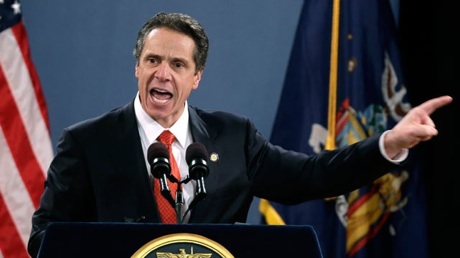Governor Cuomo
[Budget 2014]
The 2014-15 Budget Agreement holds spending growth below two percent for the fourth consecutive year, continuing a record of fiscal discipline that has reversed decades of state budgets where spending grew at a higher rate than inflation or personal income growth.
“This budget builds on the State’s progress over the past three years in order to grow the economy and create new opportunities for New Yorkers and their families,” Governor Cuomo said. “It maintains our fiscal discipline by holding spending growth below two percent, while also cutting up to $1.5 billion in property taxes to help homeowners and address the unsustainable proliferation of local governments. The budget also contains major investments in education that will transform our schools, including an increase in state aid by more than five percent and support for quality pre-k programs across the state. These investments, along with many other important provisions, are what make this budget a blueprint for success that will continue to make New York stronger, more competitive, and more affordable for all.”
Highlights of the 2014-15 budget agreement announced yesterday can be found here, and audio of the Governor’s remarks on a conference call discussing the budget can be found here – additional highlights are listed below:
Smarter New York: Transforming New York’s Schools: Teacher Excellence Fund: The Budget provides support to reward teacher excellence and recruit and retain the most highly effective educators. In order to qualify, teachers must be rated as “highly effective” and will be eligible to receive up to $20,000 in annual supplemental compensation through the Teacher Excellence Fund.
Offer a Science, Technology, Engineering and Math (STEM) Scholarship: The Budget includes $8 million in funding for a new STEM scholarship program. Full tuition scholarships to any SUNY or CUNY college or university will be offered to the top ten percent of high school graduates if they pursue a STEM career and work in New York for five years.
Connect the NY Youth Works Program to Community Colleges: To encourage more employers to hire inner-city youth, the Budget will tie the occupational training component of the NY Youth Works Program to the Job Linkage Program.
Fairer New York: Title Insurance Reform: The Budget includes measures to provide stronger oversight for the title insurance industry, which will help better protect consumers and lower costs for New York homeowners. The Budget provides the Department of Financial Services (DFS) with authority to issue licenses to title insurance agents for the first time, just as it licenses all other insurance agents and brokers. Licensing will require agents to meet qualification standards and undergo regular training. DFS will also have the authority to monitor abuse by agents and to revoke licenses accordingly, as well as help root out conflicts of interest that drive up costs for homeowners.
Together with other measures including regulations DFS will soon issue on title insurance, these reforms are expected to result in a 20 percent reduction in title insurance premiums and closing costs for new home purchases and a more than 60 percent reduction in costs on refinancing transactions.
Long Island Office of the Department of Public Service: Consistent with Governor Cuomo’s landmark legislation to restructure and improve oversight of electric service on Long Island, the Budget includes $5.5 million in funding for 39 new employees and the creation of a new Long Island Office of DPS (DPS LI). The new office will be empowered to review utility rates and operations, including storm preparedness and performance, to ensure Long Island electric customers receive reliable utility service at just and reasonable rates. PSEG Long Island, the new utility operating the electrical grid on Long Island, is seeking to freeze rates at 2013 levels through 2015.
Healthier New York: Protecting Consumers from Surprise Medical Bills: The Budget includes landmark changes designed to protect consumers against the financial nightmare of surprise medical bills from out-of-network physicians. Most importantly, it takes the consumer out of the middle of billing disputes between out-of-network medical physicians and health insurers, and holds the consumer harmless from out-of-network costs in the case of emergencies and surprise bills. The agreement also holds insurers accountable for building and maintaining robust provider networks, so consumers have sufficient in-network health care options. It also incorporates new disclosure requirements aimed at helping consumers identify whether providers are in their network, which will reduce incidents of surprise bills.
Improve Health Information Technology. Collecting and sharing health care data across providers and regions will enable better evaluation leading to more efficient resource allocation, improving the quality of service at reduced costs. The Budget includes $65 million for the State Health Information Network of New York (SHIN-NY) to continue its efforts to establish a true statewide electronic medical record system, and establish an All Payer Claims Database (APCD). This investment will leverage up to $30 million of Federal Medicaid funds for these projects for a total of up to $95 million.
Expand the Availability of Capital: Currently, many health care providers are financially disadvantaged and have limited ability to support critical infrastructure improvements. The Budget includes a new $1.2 billion capital program to support projects that improve financial stability and increase efficiency through greater provider collaboration.
Direct Care Worker COLA: The Budget includes $13 million growing to $122 million to support a 2% salary increase on January 1, 2015 and another 2% salary increase on April 1, 2015 to the lowest paid direct care workers.
Increased Opiate/Heroin Funding: The Budget includes $2 million in increased funding to enhance services to deal with this crisis.
Safer, More Resilient New York: The Budget supports continued progress toward making New York more prepared for and resilient to future emergencies. Equally important, the Budget reflects an approach to public safety that is tough, smart and fair. These priorities, taken together, will help ensure the safety of all New Yorkers in the event of an emergency.
Establish a State-of-the-Art Weather Detection System: The Division of Homeland Security and Emergency Services (DHSES) will collaborate with an academic partner to secure a private entity to establish and operate a state-of-the-art weather detection system – one of only six such systems in the nation. An initial capital investment of $15 million is being sought from Federal funding related to Superstorm Sandy.
Create a College of Emergency Preparedness, Homeland Security and Cybersecurity: The Budget includes $15 million in capital resources to fund initial planning and development costs for a new College of Emergency Preparedness, Homeland Security and Cybersecurity.
Equip Gas Stations with Back-up Power Capacity: New York is the first state in the nation with a comprehensive plan to ensure that power is maintained at strategically located gas stations in an emergency. This voluntary program is being extended to include approximately 241 Upstate gas stations within a half mile of exits on critical highways. Another $3.1 million will be made available through Federal funding related to Superstorm Sandy.
Local Capital Aid for Extreme Winter Recovery: The budget includes an additional $40 million of capital to help municipalities repair and rehabilitate local roads and bridges impacted by the extreme winter.
Protect Against Gun Violence: The Budget includes a total of $15.2 million for the GIVE (Gun-Involved Violence Elimination) initiative which focuses on reducing gun violence in New York’s communities. This program will be offered to the same communities currently receiving Operation IMPACT funding.
www.governor.ny.gov








